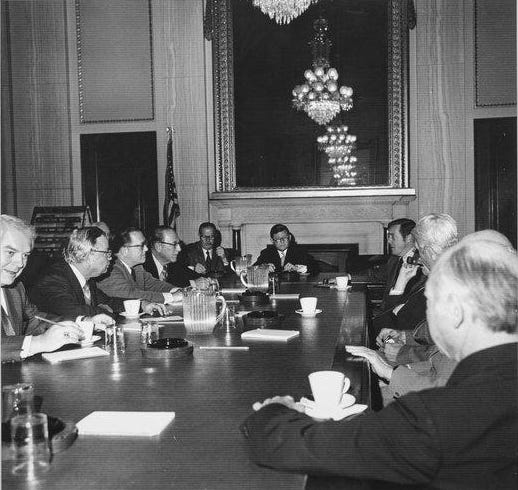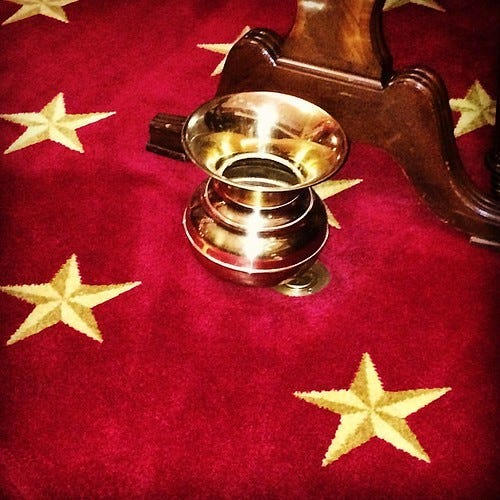How Senate Leadership Elections Work: Part I
Outside influence is unwelcome and counterproductive. The November elections will be determinative. Don't look at the contest through an ideological lens. Part I of II.
Yesterday, I discussed the remarkable 40-year career of US Sen. Mitch McConnell (R-KY), who announced in his usual undramatic, understated way that he would step down as his party’s leader in the US Senate after this year’s elections.
Now, it’s time to look forward. Senate leadership elections in November. Not just one, but several.
Having been through a few Senate GOP leadership elections, as both a GOP leadership staffer and Secretary of the Senate, I have a few observations that might help interested citizens understand the process and describe the decision-making process Senators devise in electing their leaders.
Part I will set the stage. Part II will discuss the deeply insular and personal nature of the “campaign” process and the qualities most Senators seek in leadership. I’ll tell a story or two and mention a few things to look out for. I may tiptoe through the minefield of handicapping the “field” such as it currently exists. Don’t look for me to dish any dirt or negativity. I like and respect every member of the Senate GOP Conference that I’ve met or worked with, and I plan to keep it that way. I still count a couple of Senators as friends of many decades.
I do not get involved in Senate leadership elections. I’m not weighing in on this one, either. It wouldn’t be prudent. However, channeling my inner journalist, I may outline strengths, weaknesses, and perceptions that matter not with the public but with Senators. Surprises are likely, including who may choose to run or not. There’s lots of time on the clock but little time to waste. And then there’s the elephant in the room. Most presidents and presidential candidates know weighing in on Senate leadership elections is unwise. Then again, Donald Trump has never been confused with King Solomon. The “Art of the Deal” doesn’t quite compare to the Book of Proverbs.
Someone should tell Trump that Senators aren’t going to pick someone beholden to him. It’s ultimately not about him. As the late Senator Robert C. Byrd (D-WV) used to say, he never served “under” any President. As a member of a co-equal branch of government, he served with presidents—lots of them.

Outside influence (anyone not a member of the Senate and a handful of top staff) is resisted, unwelcome, and often counterproductive. These are not jobs you “publicly” campaign for. The first scammer who decides to build a “grassroots” campaign to support or defeat a particular candidate will have the opposite effect. The same goes for the brainless sheep who support such an effort, not seeing what such “campaigns” are about (raising money and building lists for future fundraising). Senators know better than to “campaign” that way and discourage such activity.
Do you want to weigh in? Contact your Republican US Senator if you have one (sadly, I do not). Good luck with that. I can write the canned blow-off letter you’ll likely get in response. “I’ll keep your views in mind. . .”
Do lobbyists get involved? Potentially, but not likely. Suppose the lobbyist is a former Senate colleague, maybe. If a leadership candidate knows that a particular lobbyist or a mutual friend is close to a “swing vote,” he or she may ask them to “put in a good word” or perhaps call and glean information. But I would think twice if asked to do that. Again, there aren’t many secrets in the Senate. People talk, word travels, and grudges are held. Taking sides on issues is one thing. In leadership elections, as a lobbyist? Not so much.
If you get a fundraising text to send money supporting a Senator for leadership, mark it as spam and delete it. It’s all going into someone’s pocket, just like so many “draft so-and-so for President” campaigns of yesteryear. I’ve seen nothing so far, but it’s early. I will happily call out offenders. Please don’t fall for it.
The Senate has been described as the world’s most exclusive club. It comprises 100 US Senators, each elected to six-year terms from their state. As the joke goes, every newly elected Senator finds themselves awestruck as they are sworn in and humbly wonders how they got there.
After a few months, they wonder how everyone else got there.
Another joke suggests that every time a Senator looks in the mirror, they see a future president.
Let’s examine the US Senate chamber itself to understand how exclusive and hierarchical the Senate is. Organized in a semi-circle, access to the Senate floor is highly restricted. Aside from Senators, five officers, deputies, key officials, and leadership staff, very few people are allowed. Former Senators and officers who aren’t registered lobbyists also have floor access.
And look at the desks and chairs. Chairs with arms are for Senators only. A handful of chairs without arms are for staff. And there is a bench in the back for staff or others with floor access—woe to the poor staffer who sits in a chair with arms.
Let’s see if you can stay with me here. Lots of twists and turns as we contemplate our own “Game of Thrones” or “musical chairs.”
First, here are the six elected Senate GOP Conference positions, in “order,” so to speak. The Conference, currently chaired by US Sen. John Barrasso (R-WY), will set the rules and conduct the election. Since the 71-year-old Wyoming physician may be a candidate himself for either Leader or Assistant Leader (“Whip”), look for an elevated role by Vice Chair and Senator Shelley Moore Capito (R-WV), an elected leadership position.
Senate Republican Leader, held by outgoing US Sen. Mitch McConnell (R-KY).
Assistant Republican Leader, or whip. Aside from being the official number two, this is the GOP’s chief vote counter and “mobilizer.” The whip’s organization includes many “deputies” responsible for staying in touch with specific colleagues, “taking their temperature” on issues and possible votes. It’s a critical position and a natural springboard to the top job. John Thune, 63, from South Dakota, currently holds the job. More about Thune later, who unseated a sitting Senate Majority Leader, Tom Daschle, in 2004 after narrowly losing another Senate race just two years earlier. Thune was handily re-elected in 2022.
Thune’s predecessor was John Cornyn, 72, a former Texas Supreme Court justice and state Attorney General. He was elected in 2002, served as whip from 2013 to 2019, and stepped down due to a six-year term limit on all leadership positions except for the floor leader. Thune has served since and can’t seek re-election to the post in November. In recent years, prior whips elevated to the floor leadership position include McConnell and former Sen. Trent Lott (R-MS). He was last reelected in 2020. Thune was chief deputy whip under Lott in 2007-2009.
Chairman, Senate Republican Conference. This is the official “organization” of Senate Republicans and is chaired by a separate Senator (Barrasso, presently) who presides over the setting of rules (like term limits for committee chairs and leadership positions), meetings, and elections. Barrasso was elected to the Senate in 2006. The Conference also serves as the “messaging” arm of the Senate GOP, complete with a broadcast studio. Barrasso became chair in 2019 and can’t seek reelection to the post, given term limits. He’s on the ballot for reelection to the Senate this fall and is heavily favored to win.
Barrasso has two “open seats” in front of him, for Assistant Leader or Leader. Either is a promotion. Options are valuable in politics. It’s how deals get made.
Chairman, Senate Republican Policy Committee (the policy and research arm of the Senate. It is held by Sen. Joni Ernst, an Iowa Republican elected to the Senate in 2014 and just elected to the post after the 2022 elections. She succeeded former Senator Roy Blunt (R-MO), who retired after the 2022 elections.

Vice Chair, Senate Republican Conference. This position became elected, replacing “Secretary” of the Conference after 2000. Senator Moore-Capito was elected after the 2022 election, succeeding Ernst.
Chairman, National Republican Senatorial Committee (NRSC), the official campaign arm of Senate Republicans. This position was created in the 1946 Legislative Reorganization Act to separate campaign politics from official Senate activities and facilities (no doling out campaign cash on the Senate floor, as they used to, and they maintain a separate headquarters building). This job has no term limit per se, but a Senator running for reelection cannot serve as chair. Most chairs serve either a two-year or four-year stint. It is considered the first “rung” on the leadership ladder. Cornyn served as NRSC chair for the 2010 and 2012 elections, including helping elect still-serving Senators John Hoeven (R-ND) and John Boozman (R-AR) in 2010 and Deb Fischer (R-NE) in 2012.
Why does this matter? New Senators who arrived with lots of campaign cash and support from the NRSC are forever grateful. Cornyn oversaw a six-seat gain by the GOP after the 2010 election, followed by a two-seat net loss in 2012.
Leadership Elections
Caveat: Some things and procedures may have evolved and changed without my knowledge. I’ll correct the record as necessary.
Unlike real elections, I’m unaware of any procedure to “file” for a leadership position, Democrat or Republican. Someone can run and offer candidacy up to “election day.” Sometime this Fall, the Conference will announce a date for a meeting to “organize” the new 119th Congress that will likely begin “the first Tuesday after the first Monday” in the new year, January 7, 2025.
The floor leader consults a few colleagues to pick the dates for leadership elections that coincide with the orientation of the new Senators-elect. Lots of calculations, political and otherwise, go into them. In recent years, they have happened a week or so after the elections, before Thanksgiving, to help new Senators get acclimated faster. A leader nervous about leadership elections might move more quickly to prevent a challenger from emerging and organizing after a disappointing election. In other years, after the 1996 election, which ushered in a large incoming class of 16 new Senators, elections and transitions occurred in early December, after Thanksgiving.
Meanwhile, candidates are campaigning in three basic ways. First, they have multiple personal conversations, over meals and in hide-away offices with each colleague, working to secure a commitment. Second, they are raising campaign cash to dole out to colleagues and potential colleagues in elections this fall - newly elected Senators are included in the organizational conferences for the new Congress - retiring Senators are not. Third, they are helping incumbent colleagues in legislative and other ways. No favor is too small. The voting universe, after all, is very small.
Usually, a candidate for leadership counts on his seatmate from the same state to support his or her candidacy. Will Sen. Ted Cruz (R-TX) support Cornyn? Sen. Mike Rounds (R-SD) supports his senior colleague, Thune. Sen. Cynthia Lummis (R-WY) has already endorsed her senior Senator, John Barrasso. Cruz’s support, as a Senate “renegade” frequently aligned with fellow conservatives Mike Lee (R-UT), Rand Paul (R-KY), Josh Hawley (R-MO), and others, will be interesting. It’s a part of the dynamics at play.
The elections themselves are civil, at least on the surface. No matter the outcome, they have to work with each other. Competing senators or their senior staff will sometimes compare tallies of committed votes. Surprises are rare, but they sometimes discover that one senator has committed to vote for more than one candidate for the same job. One particular former Senator during my days in the Senate, who will go unnamed, was notorious for that. A rule of thumb - you need four or more “extra votes” than needed to assure victory. It’s always possible that a Senator or two will change their mind at the last moment.
Senators sometimes lie to each other.
With so many “open seat” elections for leadership positions in the GOP Conference, at least at this juncture, it might auger for a later date unless there’s a controversial leadership candidate in the mix that some want to short-circuit with an earlier election. Who knows? Game of Thrones stuff.
When the GOP Senators gather behind closed doors, likely in the Mansfield Room of the Capitol, no one other than the Senators and, maybe, a couple of staff necessary to facilitate the election will occur. The staff directors for the leadership offices won’t even be in the room. Secret votes are by paper ballot, probably a blank piece of paper and a pen where Senators will enter the name of their preferred candidate and place them in a box. It’s old-fashioned stuff, but traditions matter deeply in the Senate, where they still feature two (unused and nicely polished) brass spittoons underneath the respective leaders’ desks on the Senate floor.
No Dominion electronic voting machines will be found.
Frankly, I’ve wondered why the conference doesn’t hold the elections in the Old Senate Chamber, a stunning and historic location still used occasionally for classified meetings and briefings (no electronic devices to eavesdrop on proceedings).
Most Senators will have a pretty good idea of how most of their colleagues will vote. After all, they talk to each other and sometimes compare notes. Again, there may be suspense, but surprises and uncommitted votes are rare.
The order of things likely will start at the top, with the floor leader, and then descend the “pecking order” for subsequent offices. The Chair of the meeting will start the proceeding and then entertain nominations. Each “nominee” usually has one or two Senators briefly place their name in the nomination with a brief speech. There will be a time limit. From my experience, the candidates do not speak before the vote. Then, the secret ballots are collected.
After the votes are quickly counted, the chair will announce the results with the vote count. If there are more than two candidates in the running but no one wins a majority of the vote, the candidate with the fewest votes is eliminated. That process continues until someone wins an outright majority. When a winner is announced, he or she is invited to say a few words, usually after the losing candidates walk over to shake hands with the winner as everyone stands and applauds. Sometimes, as a courtesy and a sign of unity, the “losing” Senator will move to have his colleague “elected by acclamation.”
Sometimes, someone will exit the room to tell anxious staff and reporters who won each contest or text a staff member. Vote counts will eventually become known. Reporters will buttonhole Senators for comments if they leave the room.
Then, the next election occurs for Assistant Leader and down the line. This gives the losing candidate for leader, who may want to be considered for Assistant Leader (if they qualify), to be placed in nomination - a “plan B,” if you will.
At least three new GOP leaders will be elected in November, possibly more if incumbents Ernest, Moore-Capitol, and Daines seek to “move up.” While their terms won’t officially take effect until the new Congress convenes and returning or newly elected Senators are sworn in, the transition begins immediately.
On the Democratic side, there will be no drama. They have no term limits, and only two leadership positions are up for votes - the leader (Charles Schumer, D-NY) and assistant leader (Richard Durbin, D-IL), unless one of them chooses to step down (unlikely). The floor leader appoints all other leadership positions in the Democratic Conference.
In other words, the Republican conference is more “democratic” than the Democratic conference.
Part II: The qualities looked for in “leadership” candidates. It’s more about the relationships and internal politics than “external” factors, except when it’s not.







This is a great insider's look at the selection process for the next Leader. Excellent stuff.